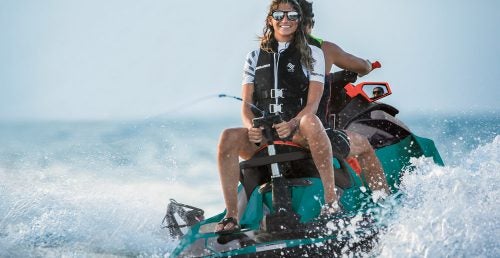2018 Sea-Doo GTS Review
The 2018 Sea-Doo GTS is an affordable, entry level PWC, but it is a notable step up from the innovative Spark in terms in size and storage.
Engine: Three-cylinder 900cc
Fuel Capacity: 15.9 gallons
Storage Capacity: 30.8 gallons
Seating Capacity: 3
MSRP: $7,699
With all the hype surrounding the innovative Spark, a craft like the entry-level 2018 Sea-Doo GTS often goes overlooked. It shouldn’t. For those that want a larger craft that better handles challenging conditions or perhaps plan to frequently haul two passengers, the GTS is the roomier, more stable alternative. The GTS also offers far better storage and comfort.
And yet, the Spark’s influence is strong. As we saw last year, Sea-Doo turned to Spark technology in a bid to make the 2018 Sea-Doo GTS one of the most affordable full-size watercraft on the market. The result is the familiar “something old, something new”…and a craft worthy of attention.
Spark DNA
Sea-Doo took a cue from the Spark for its 2017 makeover of the GTS. Yes, the craft still looked much the same, with its stylish lines and upscale appearance, but below the surface many of the Spark’s same building blocks were revealed. That black hull is the Spark’s familiar PolyTec, a polypropylene composite with reinforcement from long-strand glass fibers. It’s rugged and durable, able to be driven up on a beach without damage or whacked into a piling while docking without the potential crunch produced by fiberglass. Bathed in black, it also won’t show scratches or have its matte appearance stand out from the traditional construction, brightly colored hull above. As on the Spark, the hull attaches to the deck with a watertight gasket and a series of bolts.
PolyTec can be produced more affordably, but perhaps most importantly it’s lighter in weight. Switching to PolyTec shaved significant pounds off the hull, making it possible to – like the Spark – use a lighter weight, lower horsepower engine. That engine is the now-familiar Rotax 900 HO ACE. Yes, it only produces 90 horsepower, but Sea-Doo has repositioned the GTS to be more affordable ($300 less expensive than the 2016 GTS), and hopes the target audience is willing to accept any tradeoffs. The good news is that acceleration is much the same, thanks to the overall 150-pound weight reduction delivered by the engine/hull combo. Fuel efficiency also promises to be better than the previous engine by as much as 30%, significantly stretching the gas budget. But yes, top speed is lower, and noticeably so. The GTS peaks at about 44 mph, making it one of the slowest craft on the market. Keep in mind, however, that most recreational riders will likely spend much of their time at cruising speeds. For those that don’t care about top speed thrills, it makes economic sense.
This…Or That?
With these facts in mind, let’s revisit the Spark comparison. At 132.6” in length, the $7,699 GTS is over a foot longer than the three-up Spark ($6,739 w/front storage); at 48.5” in beam, it’s 2.5” wider. The saddle is also longer, wider, and more luxuriously padded. This overall bigger footprint gives the GTS a better presence in rougher water conditions, and an obvious advantage in passenger room and comfort. Adding to the latter are the GTS’s ergonomic features, including inwardly slanted footwells to more naturally align rider’s knees and the absence of footwell angles to always keep feet in contact with a solid surface.
The 2018 Sea-Doo GTS is also capable of carrying far more gear, with a generous 30.8-gallon storage capacity compared to the Spark’s mere 7 gallons, the latter only available should you choose the optional front storage compartment.
The tradeoff, of course, is that the GTS doesn’t have the Spark’s unique looks, or spirited playfulness. Yes, its shallow 16-degree deadrise gives the craft a little more of that old-school slide or spin when desired, but overall it’s a calmer, gentler ride than the Spark. Those that want to toss the craft around and freestyle will likely prefer the Spark’s handling, while those that want that bigger presence in bigger waters will probably tilt toward the GTS. In fairness, however, the GTS also handles more aggressively when desired, locking into corners with more precision.
Other features are similar to both craft. Dual acceleration profiles – the calmer Touring or more-aggressive Sport – are available. The GTS adds ECO mode for best fuel conservation. Dual lanyards can also govern speed, with a secondary lanyard dramatically curtailing top-end for new or younger riders. At the base price point, however, neither offers Intelligent Brake & Reverse (iBR).
Tough Choices
So which craft gets the nod? The point of this article is to let you make that choice with a little more information, not to make up your mind for you. The Spark is a great craft, but if you’re making a choice based mostly on price, the 2018 Sea-Doo GTS deserves more attention than it will likely get. Yes, it’s slower and less playful, but it’s also bigger and more comfortable, and arguably the better choice for bigger, rougher waters.
Competitors outside the Sea-Doo brand also deserve consideration, specifically the Yamaha EX Sport ($7,699), which adds mechanical reverse and a reboarding step.
Get PersonalWatercraft.com in your Inbox!
Like PersonalWatercraft.com on Facebook
Comments
Most Popular

Remembering the Sea-Doo XP

2025 Yamaha JetBlaster PRO 2-Up Review

2024 Kawasaki Jet Ski STX 160X Review

2024 Yamaha GP HO Review

2017 Kawasaki Jet Ski Ultra 310LX Review
















 Your Privacy Choices
Your Privacy Choices